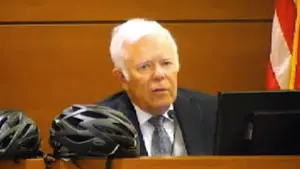

The Expert: Dr. Harry Smith, a biomechanical and injury causation expert, testifying for the defense on the impact and the doctor/cyclist’s physical condition at the time of the collision.

In a 2017 Florida trial, Dr. Harry Smith, a biomechanical and injury causation expert, testifies for the defense regarding the potential cause of a fatal a bicycle crash. The plaintiff in this case was the family of a physician who died after his bicycle ran into a landscaping truck that was parked on the roadside where bikes usually travelled. The defense contended that the physician was negligent in having his head down while he was riding and also in going on an extended bike ride on a hot day without sufficient water, dehydrating him and affecting his judgment.
Smith begins his testimony in this video clip by discussing the reasons why the bicyclist had a blood glucose over 300. In trauma, catecholamines, including epinephrine, are released in response to the stress of the trauma. These hormones then release stored glucose, increasing the body’s sugar levels. This is a normal response that is commonly noted and the expert testifies that this is of no consequence and would be expected to return to normal when the stress is no longer present.
The expert tells jurors that patient’s head injury was consistent with the impact that was observed at the scene and resulted in a Glasgow Coma Scale number of 3. This scale provides healthcare workers with a method for assessing the impairment of the level of consciousness by testing the patient’s response to defined stimuli. The level of consciousness is quantified by observing the patient’s ability to open his eyes in response to stimuli, give a verbal response that is meaningful, or move his body in response to stimuli. After this assessment, the patient is assigned a number for each of these categories based upon these responses. Those numbers are then added together to give a total score which will range from 3 which is totally unresponsive to 15 which is the number given to a completely awake and alert individual. A number of less than 9 is indicative of a comatose patient. A patient with a score of 3 would imply having no reactions to stimuli and “also resembles death.”
Smith then offered his opinion that the patient was significantly dehydrated at the time of the accident. This is important when high level cardiovascular exercise is happening results in an elevation of the body temperature. The body’s normal response to this heating is to cool itself down by sweating. The water component of blood and cells is brought to the surface of the skin where it is evaporated, resulting in energy loss and cooling. Replenishing this with oral hydration is important; if this does not occur, one becomes dehydrated. In this case, two hours of bicycling in the extreme heat and humidity would exacerbate this situation. Notably, when the cyclist was discovered by rescue services, he was conspicuously hot and dry rather than sweaty. Smith says that this is an indication that he was severely dehydrated, since his body could not produce the sweat it needed to cool down.
Under questioning by the defense attorney, Dr. Smith discusses the findings at the scene of the accident. The patient had fixed and dilated pupils. This is because the pupil has lost its connection to the brainstem. It can no longer react appropriately to light by constricting and instead remains fully dilated despite light being shined into it. This is an indication of a severe brain injury. The accident caused bleeding under the skin around the bulging eye confirming a significant impact injury to the head, which would support suspicions of a traumatic brain injury.
The jury granted a $3 million verdict, but based on the expert’s testimony, found the bicyclist to be 70% at fault, setting up a post-verdict award of $1 million.
Gary Gansar, MD, is residency-trained in general surgery. He served as Chief of Surgery and Staff at Elmwood Medical Center and on the Medical Executive Committee at Touro Infirmary and Mercy Hospital in New Orleans, LA. Dr. Gansar was Board Certified in general surgery while in active practice. He joined AMFS in 2015 as a Physician Medical Director.
The medical expert witness partner for attorneys serious about building a winning case
AMFS is your trusted source for highly-qualified medical expert witnesses. After pioneering the field nearly three decades ago, we’re continuing to redefine medical expert witness services by providing value far beyond a referral alone.
Our Physician Medical Directors know what it takes to build a strong case. Our medical expert witnesses leave no doubt. And our case managers streamline billing and logistics every step of the way, letting you focus on what you do best: constructing your winning case. Explore why AMFS clients expect more from their medical expert witnesses—and get it.
